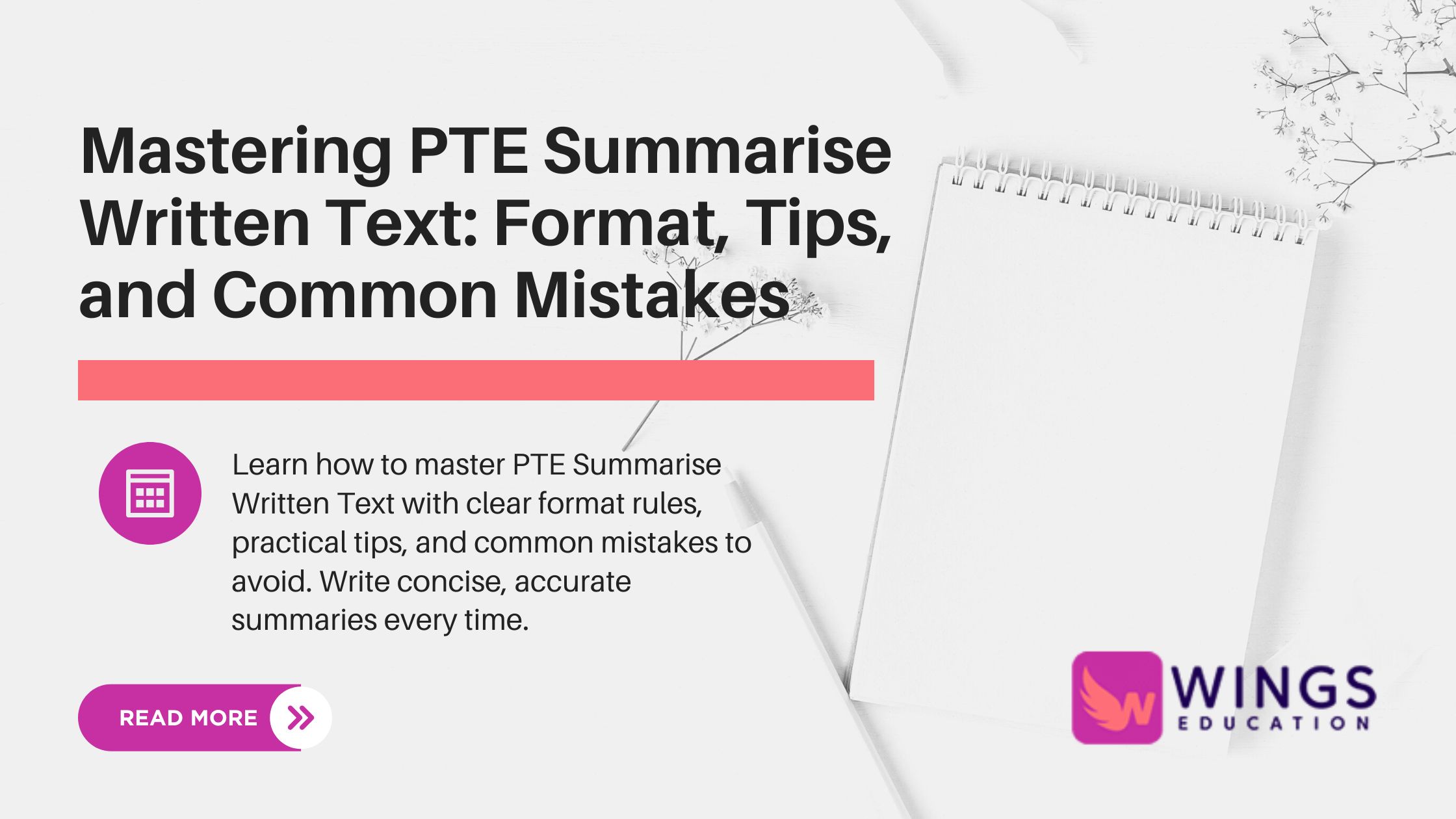
Mastering PTE Summarise Written Text: Format, Tips, and Common Mistakes
Learn how to master PTE Summarise Written Text with clear format rules, practical tips, and common mistakes to avoid. Write concise, accurate summaries every time.
If there is one task in the PTE Writing section that tests your clarity of thought, it’s Summarise Written Text (SWT). You get a long paragraph full of ideas, arguments, data, and examples—yet your job is to compress everything into one single sentence of 5–75 words. No more, no less. This task might look small on the surface, but its impact is huge. It contributes not only to your Writing score but also to your Reading score. That means mastering it boosts two sections at once. And that’s exactly where many students struggle—not with understanding the paragraph, but with converting it into a clean, accurate, and grammatically perfect sentence. This guide walks you through everything you need to know: the format, the dos and don’ts, the subtle techniques, and the common traps that students fall into. If you’re aiming to master PTE Summarise written Text in 2025, this is your roadmap.
Understanding the Task Format: Simple but Strict
The Summarise Written Text task looks simple at first, but it follows very strict rules. You’re given a medium-length passage—usually between 150 and 300 words—and your job is to turn all of that information into one single sentence. Not a short paragraph. Not two neat lines. Just one sentence that captures the heart of the passage. To perform well, you must respect a few fixed requirements. The word limit is tight, allowing only 5 to 75 words, but realistically you should aim for a balanced sentence that’s neither too short nor too long. The time limit of 10 minutes makes it a quick-thinking task, pushing you to read, understand, summarise, and edit with focus. It’s also important to remember that this task affects both Writing and Reading scores, so accuracy matters. The system evaluates your grammar, checks whether your content matches the passage, and looks at how well your sentence structure and vocabulary hold together. Because of these rules, the summary must be clean and direct. There’s no room for introductions, opinions, examples, or decorative language. You are simply expected to distill the essence of the text into a well-crafted line. Most of the time, students lose marks because they break one of these simple rules—such as writing two sentences, going off-topic, or making the summary too long. Once you follow the format strictly and focus on expressing the central idea clearly, Summarise Written Text becomes far easier to master.
How to Read the Passage Smartly (Without Wasting Time)
When it comes to Summarise Written Text, you don’t need to read every word with full attention. The task is all about capturing the big idea, not memorising every detail. The smartest approach is to read strategically instead of slowly working through each line.
A good way to start is by looking at the first two sentences, because they usually introduce the topic and set the direction of the passage. These lines often tell you what the author wants to discuss. Then, move to the last two sentences, which usually wrap up the main point, highlight the author’s final message, or offer a conclusion. Together, the beginning and end give you a strong sense of the overall intention of the text.
Once you understand the opening and closing ideas, you can skim through the middle. Don’t worry about every example or statistic. Instead, look for repeated words, recurring themes, or patterns in the argument. When something appears more than once, it’s typically a key idea worth keeping in your final summary.
Your ultimate goal is to identify the central idea that ties everything together. Every academic passage has one primary message, even if it carries several smaller details. Your summary should express that main message in a compressed, meaningful way.
The biggest mistake is trying to include everything the passage talks about. A summary is not a shopping list of facts. It’s a cleaner, shorter version of the author’s main point.
If you master this way of reading—fast, strategic, and focused—Summarise Written Text becomes far easier and quicker to handle.
How to Structure Your One Perfect Sentence
Creating the ideal SWT sentence is like building a small but well-connected train. The main idea acts as the engine, leading the sentence. The supporting ideas follow behind like wagons, adding meaning without overpowering it. And the connectors—words such as while, although, because, which, or therefore—work like couplers, linking everything smoothly.
A simple way to build your summary is to follow this structure:
Main Idea + Linking Word + Important Supporting Point
Using just one strong connector helps you combine ideas clearly without turning the sentence into a long, confusing chain.
For example:
“The passage explains X, while also highlighting Y, which suggests Z.”
It’s clean, compact, and accurate—exactly what the task demands.
Length Matters: 30–50 Words Is the Sweet Spot
Yes, the official limit is 5–75 words, but the safest place is:
30 to 50 words
Why?
Under 30 words may sound incomplete.
Above 60 often becomes confusing or grammatically risky.
Between 30–50 is the perfect balance of clarity and conciseness.
Students who consistently score high stay in this range—it’s long enough to capture meaning, short enough to stay error-free.
Semi-Points Style Strategies to Master PTE Summarise Written Text
Here are practical, proven techniques presented in a semi-points narrational style—easy to read yet not fully bullet-pointed:
- Start by identifying the primary topic of the passage; there is always one main message hiding in the first and last lines. Most passages introduce their subject in the opening lines and circle back to the core idea toward the end, making it easier to spot what the author wants to emphasise. Instead of getting lost in examples or extra details, focus on this main message. Once you recognise the central idea, the rest of the summary becomes far easier to build with clarity and confidence.
- Notice the theme that repeats—authors usually circle around a central concept through examples and explanations. In most passages, the writer keeps returning to one dominant idea, even if the text includes multiple facts, arguments, or illustrations. These repeated words or concepts act like signals, guiding you toward what truly matters. Instead of focusing on every detail, pay attention to the ideas mentioned more than once, as they reveal the passage’s core message and help you understand what your summary should highlight.
- Pick one major supporting idea instead of trying to squeeze everything into your summary. A strong summary doesn’t try to fit every detail from the passage into one sentence. Instead, choose the most important supporting idea that strengthens or explains the main message. This helps keep your summary focused, accurate, and manageable within the word limit. When you prioritise just one key point, your sentence becomes cleaner, easier to structure, and far less likely to contain grammar mistakes or unnecessary complexity.
- Use one connector to combine ideas smoothly; avoid using two or three because they make the sentence long and risky. A single, well-chosen linking word is enough to connect the main idea and the key supporting point without overcomplicating your structure. When you add multiple connectors, the sentence often becomes too long, harder to control, and more prone to grammar errors. By sticking to just one connector, you keep your summary clean, focused, and easy for the reader—and the PTE scoring system—to follow accurately.
- Keep your sentence active, not passive, as active structures are clearer and usually shorter.
Active voice helps you express ideas directly, making your summary easier to read and more concise. In active sentences, the subject performs the action, which keeps the structure straightforward and avoids unnecessary words. Passive voice often adds extra phrases like “is,” “was,” or “by,” which can make your one-sentence summary longer and harder to control. Staying active helps maintain clarity and reduces the chance of grammatical mistakes. - Replace direct details with general phrases like “the passage discusses,” “the author highlights,” or “the text emphasizes.” This approach helps you avoid getting stuck in specific examples, numbers, or names that can complicate your sentence. Using general academic phrases allows you to express the core message without copying too much from the passage. It also keeps your summary flexible, concise, and easier to structure. These broad expressions smoothly introduce the main idea and make your one-sentence summary sound polished and well-controlled.
- Avoid listing multiple examples; use words like “various,” “different,” or “several” to keep it general. Listing every example from the passage makes your sentence long, awkward, and difficult to manage within the one-sentence limit. Instead of repeating each detail, use general words that combine them into a single idea. Terms like “various,” “several,” or “different” help you summarise multiple points without overcrowding your sentence. This keeps your writing concise, focused, and much easier to read while still capturing the essence of the passage.
- Use simple vocabulary—your goal is accuracy, not showcasing complex words.
In Summarise Written Text, clarity matters far more than using advanced or academic-sounding terms. Complicated vocabulary often leads to confusion, incorrect usage, or awkward sentence structures. Simple words help you express ideas directly and reduce the chance of grammatical errors. Remember, the task rewards accuracy, relevance, and readability. Using clear language allows you to focus on the meaning of the passage instead of worrying about whether the word you chose fits correctly. - Check for run-on sentences; if your sentence feels never-ending, break it and rebuild it more clearly. Run-on sentences are one of the most common reasons students lose marks in Summarise Written Text. When you keep adding ideas without proper structure, the sentence becomes confusing and grammatically unstable. If you notice your summary stretching too long, pause and restructure it by focusing only on the main idea and one key supporting point. Rebuilding the sentence with a cleaner flow ensures clarity, accuracy, and better control within the one-sentence limit.
These semi-point strategies keep your writing clean, coherent, and safe, especially under time pressure.
A Step-by-Step Method to Build Your Summary in Minutes – Described Version
1. Read once for the main idea
Start with a quick, relaxed read. Your only goal here is to understand the overall direction of the passage. Don’t stress about details or examples. Just get a sense of what the text is broadly trying to talk about. This first read gives you the “storyline” you’ll later summarise.
2. Read again and spot the core message
On the second read, look deeper. Ask yourself: “If I had to explain the entire passage in one clear sentence, what would I say?”
The answer to that question becomes the backbone of your summary. It’s the single idea that ties everything together and reflects the author’s main purpose.
3. Identify one or two important supporting ideas
Now look for the strongest points that support or extend the main idea. These might be explanations, reasons, or important findings. Don’t choose too many—one or two are enough to keep your summary balanced without making your sentence heavy or confusing.
4. Combine main + supporting ideas with one connector
Use a clean, simple linking word to join your ideas smoothly. One connector is all you need to keep your sentence structured and readable. Too many connectors can turn your summary into a long, risky chain. A single, well-chosen connector keeps the meaning intact and the grammar stable.
5. Write your final sentence (30–50 words)
Turn your main idea and supporting point into a single polished sentence. Keep the tone formal, the wording clear, and the structure steady. The 30–50 word range is ideal—it gives enough space to express the full meaning without slipping into run-on territory.
6. Spend the last 60–90 seconds editing
This final step often saves marks. Check punctuation, grammar, capital letters, and the final period. Make sure your sentence reads smoothly and matches the actual passage. A quick edit can fix small mistakes that would otherwise lower your Writing score.
Common Mistakes Students Make (and How to Avoid Them)
Most students lose marks not because they don’t understand the text, but because they do one of these common errors.
Let’s break them down:
1. Writing more than one sentence
Many students lose easy marks simply because they use a second full stop. The system strictly requires one single sentence, no matter how long the passage is.
A second sentence—even a short one like “This affects results.”—will make the whole response incorrect.
Instead, use commas, conjunctions (and, but, because), or relative clauses (which, that) to connect ideas smoothly within one sentence.
2. Copying too many words from the text
While copying keywords is fine, copying long chunks makes your summary look robotic. The software detects when the answer feels overly dependent on the original text.
Your goal is to show understanding, not just reassemble sentences from the passage. Blending your own wording with key terms creates a cleaner, more natural summary.
3. Adding your own opinion
Your personal thoughts—what you agree with, disagree with, or believe—must never appear in this task.
The summary should purely reflect the author’s message, not your interpretation. Even soft phrases like “This is important because…” can be considered opinion.
4. Trying to cover every detail
Students often panic and try to include every fact from the text, which leads to a long, messy sentence.
A summary is about the central idea, not examples, statistics, or supporting details. Focus on the main message, not the entire story.
5. Overusing connectors
Using too many linking words—such as “however,” “moreover,” “therefore,” “although”—in one sentence often creates grammatical errors.
Choose one strong connector, place it correctly, and keep the sentence simple. Clarity matters more than sounding complex.
6. Writing too short or too long
If the summary is under 20 words, it usually misses the main idea and becomes vague.
If it crosses 60 words, it becomes harder to control grammar and structure, increasing the chance of mistakes.
The sweet spot is usually 30–45 words where clarity, structure, and meaning balance well.
7. Capitalization and punctuation errors
This is a writing task, so even minor errors—like missing capital letters, misplaced commas, extra spaces, or unnecessary punctuation—can cost marks.
Start with a capital letter and end with a full stop. Keep everything else clean and simple.
8. Ignoring the conclusion of the passage
The last part of the passage often reveals the real purpose or final message of the text.
If you skip it or focus only on the beginning, your summary may miss the main idea. Always read from start to finish before writing.
What a Good Summary Should Look Like
A strong Summarize Written Text (SWT) response captures the central idea of the passage in one clear sentence without adding unnecessary details or opinions.
Let’s break down why the example works so well:
Original idea (from the imaginary passage):
The passage talks about rising urban pollution caused by traffic, industrial waste, and population growth. It also mentions that although governments are trying to solve these issues, their efforts are limited because they lack funds and face public resistance.
Good SWT Summary (example):
“The passage explains that increasing urban pollution results from traffic, industrial waste, and population growth, while government efforts to address the issue remain limited by financial constraints and public resistance.”
Why This Summary Is Effective
- It captures all major causes
It includes the three key reasons for rising pollution mentioned in the text—traffic, industrial waste, and population growth—without adding anything extra.
- It connects both parts of the passage
The summary doesn’t just mention the problem; it also refers to the government’s struggle to fix it. This balance shows full understanding of the passage.
- It keeps everything in ONE sentence
There are no full stops, and the sentence flows logically using simple connectors like “while.”
- It stays concise and focused
At around 40–45 words, it meets PTE’s recommended length. It doesn’t try to cover every detail—only the core message.
- It avoids personal opinions
The writer does not judge the government, suggest solutions, or add interpretations. It strictly reflects the original text.
- It is clear and easy to read
The structure is clean, the connectors are appropriate, and the grammar is solid. This helps score well in content, form, grammar, and vocabulary.
Advanced Techniques to Score Higher in 2025
1. Identify not just the what, but the why
A high-scoring summary goes deeper than repeating information. Strong writers understand the author’s intention—why the information is presented. This helps you capture the true central message rather than small details.
2. Convert multiple examples into one broad idea
Passages often list several examples to support one point. Instead of mentioning each example, replace them with a general category like “several technological innovations” or “various environmental challenges.” This keeps your sentence clean and academic.
3. Use relative clauses to combine ideas
Words like which, that, or who help you merge two pieces of information smoothly.
Example:
“Urban pollution is increasing because of traffic and waste, which shows how multiple human activities contribute to the problem.”
This reduces sentence breaks and improves flow.
4. Practice compression (shrinking long phrases)
Long phrases such as “a significant number of people who live in large cities” can be compressed to “many urban residents.”
Compression improves clarity, reduces word count, and makes your summary more professional.
5. Stay neutral—avoid emotional or judgmental words
Your sentence should sound objective. Avoid words like “terrible,” “amazing,” “surprising,” or anything that reveals personal reaction. PTE prefers academic tone, not opinion.
6. Keep the main subject clear from the start
Starting with long dependent clauses confuses readers and increases grammar errors.
Instead of:
“Although cities face many issues caused by rapid growth, the passage explains…”
Prefer:
“The passage explains that cities face issues due to rapid growth…”
This helps you maintain control over sentence structure.
7. Maintain logical sequencing
Good summaries follow natural thinking patterns:
- cause → effect
- problem → solution
- claim → evidence
This makes your one-sentence summary easy to read and understand, even when combining multiple ideas.
Advanced Techniques to Score Higher in 2025
As PTE evolves, clarity and precision matter more than ever. Here are deeper-level techniques for top scorers:
- Focus not just on what the author says, but on why they say it; the purpose often reveals the main idea.
- Convert multiple examples into one general concept—“various scientific studies,” “multiple historical events,” “several environmental challenges.”
- Use relative clauses (“which shows,” “that explains,” “which highlights”) to combine ideas smoothly.
- Rewrite long phrases into tighter, simpler versions, a technique called compression.
- Avoid emotional or evaluative words; stay neutral and academic.
- Keep the subject of your sentence clear from the beginning; don’t start with long dependent clauses.
- Maintain logical flow—cause to effect, problem to solution, claim to evidence.
These techniques help refine your writing beyond the basics.
Practising the Right Way: What Matters in SWT Prep
If you want to truly master PTE Summarise Written Text, focus on:
- Practising with passages from academic sources like science, environment, history, and economics
- Doing timed exercises—10 minutes per task
- Learning to paraphrase without losing meaning
- Studying high-quality sample answers
- Writing summaries in different styles and comparing them
- Keeping a list of useful connectors and academic verbs
Practice smart, not hard. SWT is a skill that grows rapidly with the right approach.
Final Thoughts: Clarity Wins in Summarise Written Text
In a test filled with multiple-choice questions, audio clips, and technical scoring rules, Summarise Written Text is refreshingly straightforward—yet challenging in its own way.
You’re judged on your ability to:
- Understand complex text
- Filter the essential idea
- Connect supporting points
- Maintain perfect grammar
- Express everything in one clear sentence
Mastering this task sharpens not only your writing but also your analytical thinking.
If you keep the strategies in this guide at the heart of your practice, avoid common mistakes, and stay within the safe word range, you’ll be well on your way to confidently Mastering PTE Summarise Written Text in 2025 and beyond.






















